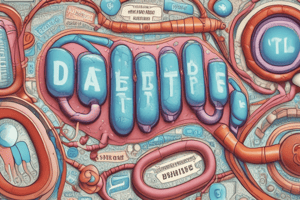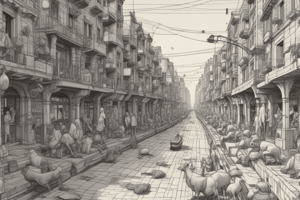Podcast
Questions and Answers
What is a core characteristic of the interpretation of a text according to the text?
What is a core characteristic of the interpretation of a text according to the text?
- One correct concept of ultimate reality
- Subjectivity and perspectivalism (correct)
- Dependence on grand metanarratives
- Objective reality
Which historical approach focused on language change over long expanses of time?
Which historical approach focused on language change over long expanses of time?
- Semiotics
- Diachronic Philology (correct)
- Structuralism
- Post-Structuralism
What did pre-Saussurean Linguistics believe about the structure of language?
What did pre-Saussurean Linguistics believe about the structure of language?
- Language changes only phonologically
- Languages should not be compared
- Language reflects objective reality
- Language has no structure of its own (correct)
What is the most accurate description of truth?
What is the most accurate description of truth?
According to the mimetic theory of language, what does a symbol (a word) represent?
According to the mimetic theory of language, what does a symbol (a word) represent?
What does Saussure's synchronic approach to language focus on?
What does Saussure's synchronic approach to language focus on?
How does Saussure's view on language structure differ from the mimetic theory?
How does Saussure's view on language structure differ from the mimetic theory?
What are the basic units in a language according to Saussure?
What are the basic units in a language according to Saussure?
What is a key difference between a map and a collage according to the text?
What is a key difference between a map and a collage according to the text?
According to postmodernism, what is the view on reality?
According to postmodernism, what is the view on reality?
How does the text describe the process of creating meaning from a collage?
How does the text describe the process of creating meaning from a collage?
What is emphasized as the postmodern maxim in relation to understanding reality?
What is emphasized as the postmodern maxim in relation to understanding reality?
According to Saussure, what is 'parole' in the context of language?
According to Saussure, what is 'parole' in the context of language?
How does Saussure define 'langue'?
How does Saussure define 'langue'?
What is the main consequence of the reversal of presence and absence established by the transcendental signified in Derrida's philosophy?
What is the main consequence of the reversal of presence and absence established by the transcendental signified in Derrida's philosophy?
What does Saussure propose about the relationship between the signifier and the signified in a linguistic sign?
What does Saussure propose about the relationship between the signifier and the signified in a linguistic sign?
How does Derrida's philosophy challenge traditional worldviews?
How does Derrida's philosophy challenge traditional worldviews?
Why does Saussure reject the idea of a word being a direct symbol of its referent?
Why does Saussure reject the idea of a word being a direct symbol of its referent?
What role does 'difference' play in human knowledge and self-identity according to the text?
What role does 'difference' play in human knowledge and self-identity according to the text?
Why does the text suggest that all interpretation concerning life, self, and knowledge is possible and probable?
Why does the text suggest that all interpretation concerning life, self, and knowledge is possible and probable?
Flashcards
Text Interpretation
Text Interpretation
The process of understanding text, which depends on the reader's perspective and is not a fixed meaning.
Diachronic Approach
Diachronic Approach
Studying language change over time.
Pre-Saussurean Linguistics
Pre-Saussurean Linguistics
The idea that words directly represent their meaning.
Mimetic Theory
Mimetic Theory
Signup and view all the flashcards
Saussure's Synchronic Approach
Saussure's Synchronic Approach
Signup and view all the flashcards
Arbitrary Signs
Arbitrary Signs
Signup and view all the flashcards
Saussure's Signs
Saussure's Signs
Signup and view all the flashcards
Map vs. Collage
Map vs. Collage
Signup and view all the flashcards
Postmodernism
Postmodernism
Signup and view all the flashcards
Collage Meaning
Collage Meaning
Signup and view all the flashcards
Postmodern Maxim
Postmodern Maxim
Signup and view all the flashcards
Langue
Langue
Signup and view all the flashcards
Parole
Parole
Signup and view all the flashcards
Derrida's Philosophy
Derrida's Philosophy
Signup and view all the flashcards
Linguistic Sign
Linguistic Sign
Signup and view all the flashcards
Difference (in Philosophy)
Difference (in Philosophy)
Signup and view all the flashcards
Challenging Traditional Worldviews
Challenging Traditional Worldviews
Signup and view all the flashcards
Rejecting Direct Symbolism
Rejecting Direct Symbolism
Signup and view all the flashcards
Subjective Truth
Subjective Truth
Signup and view all the flashcards
Study Notes
Text Interpretation
- A core characteristic of text interpretation is that it depends on the reader's understanding and is not fixed.
Historical Approach to Language
- The diachronic approach focused on language change over long expanses of time.
Pre-Saussurean Linguistics
- Pre-Saussurean Linguistics believed that the structure of language is based on a direct connection between words and their referents.
Truth
- The most accurate description of truth is that it is subjective and relative.
Mimetic Theory of Language
- According to the mimetic theory of language, a symbol (a word) represents a direct copy of its referent.
Saussure's Synchronic Approach
- Saussure's synchronic approach to language focuses on the language system at a particular point in time, studying how signs relate to each other.
Saussure's View on Language Structure
- Saussure's view on language structure differs from the mimetic theory, as he believes that signs are arbitrary and unrelated to their referents.
Basic Units in Language
- The basic units in a language, according to Saussure, are signs, comprised of a signifier (sound or image) and a signified (concept or meaning).
Map and Collage
- A key difference between a map and a collage is that a map is a fixed representation, while a collage is a dynamic and subjective creation.
Postmodernism
- According to postmodernism, reality is subjective and fragmented, with multiple truths and meanings.
Creating Meaning from a Collage
- The process of creating meaning from a collage involves the reader's interpretation and connection of different elements.
Postmodern Maxim
- The postmodern maxim is that reality is what we construct through our individual perspectives and experiences.
Saussure's Concepts
- In the context of language, 'parole' refers to individual instances of language use, while 'langue' refers to the overall language system.
Derrida's Philosophy
- The main consequence of the reversal of presence and absence established by the transcendental signified in Derrida's philosophy is that it challenges traditional notions of truth and meaning.
Linguistic Sign
- Saussure proposes that in a linguistic sign, the signifier and the signified are arbitrarily related, with no direct connection between the sound/image and the concept/meaning.
Challenging Traditional Worldviews
- Derrida's philosophy challenges traditional worldviews by questioning the existence of fixed, objective truths and meanings.
Rejecting Direct Symbolism
- Saussure rejects the idea of a word being a direct symbol of its referent because it overemphasizes the connection between the signifier and the signified.
Role of Difference
- 'Difference' plays a crucial role in human knowledge and self-identity, as it highlights the uniqueness and individuality of each person's perspective.
Interpretation of Life, Self, and Knowledge
- All interpretation concerning life, self, and knowledge is possible and probable because of the subjective nature of truth and meaning.
Studying That Suits You
Use AI to generate personalized quizzes and flashcards to suit your learning preferences.




